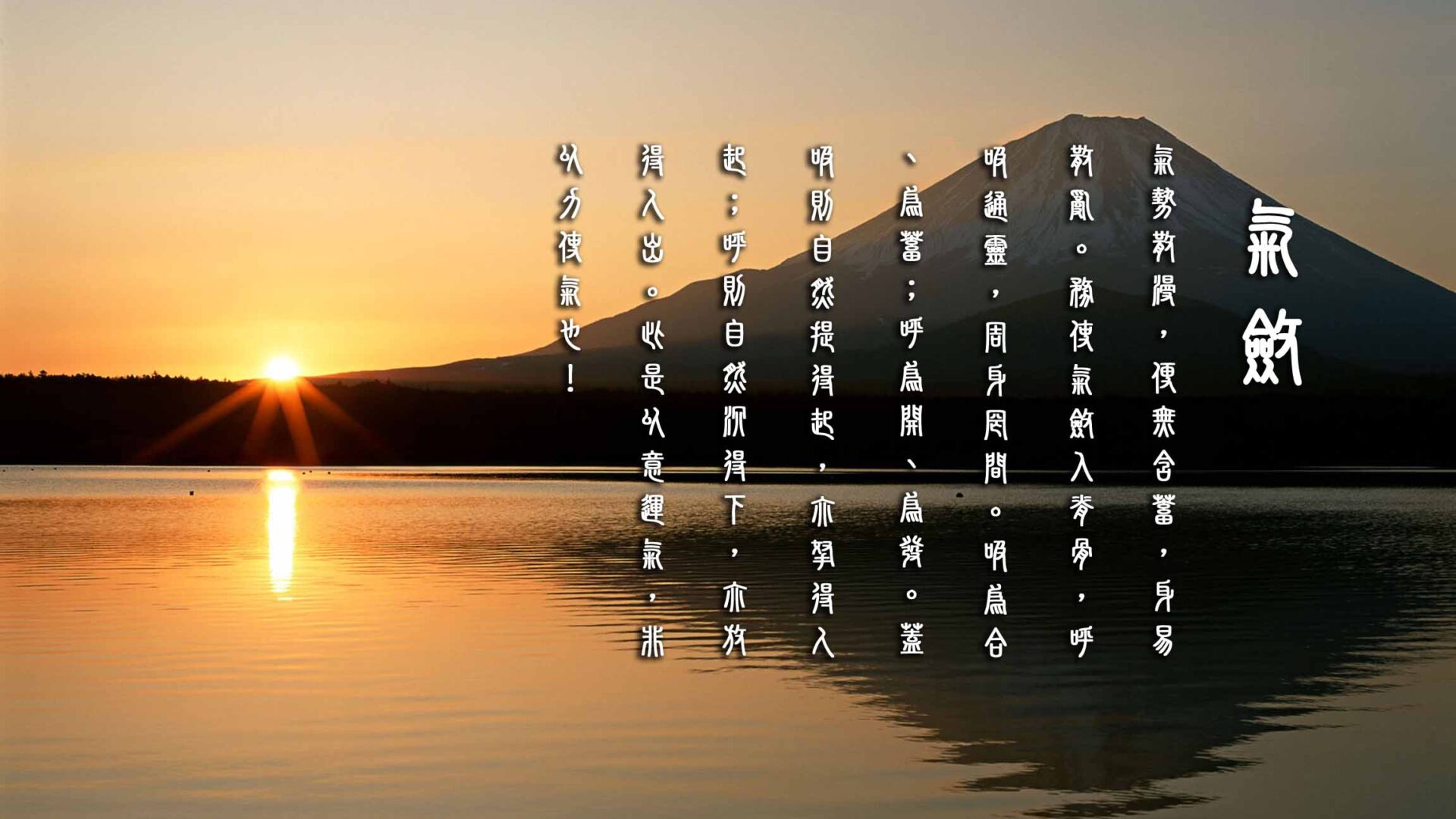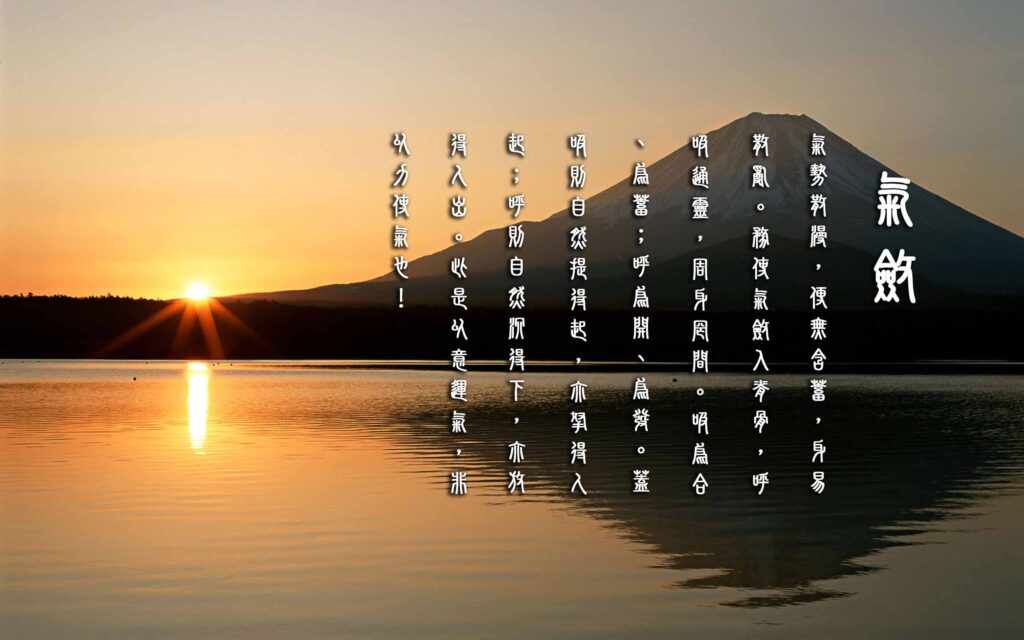氣勢散漫,便無含蓄,易散亂。務使氣斂入脊骨。吸呼通靈,周身無間。吸為合為蓄,呼為開為發。蓋吸則自然提得起,亦拿得人起;呼則自然沉得下,亦放得人出。此是以意運氣,非以力使氣也。
TRANSLATION:
If internal force is undisciplined, then it is not stored and it is easy to scatter. Allow internal force to converge onto the spine, moving in and out unimpeded throughout the whole body. The term IN is used to define when internal force moves inwards which also means to close or to gather. The term OUT is used to define when internal force moves outwards which also means to open or to release. The internal force of IN naturally lifts up to uproot your opponent. The internal force of OUT naturally sinks down to expel your opponent. This is done through the use of intention to move your internal force as opposed to using brute strength to mobilize your force.
Internal Force or Qi
The Chinese word “qi” is used throughout the verse. We translated it to “internal force”. The word qi can be confusing as the same word used in different contexts mean different things. When referring to breathing, qi is the air that we breathe. In Traditional Chinese Medicine or health related topics, qi typically means the life force that runs through all living things. Only in the tai chi world would qi mean internal force.
We experience this internal force as pressure changes that we feel inside our body. If you have been practicing for a while, you will have already experienced and understood this feeling. If you are beginning your tai chi learning, you may have felt it from time to time when you are focused on practicing and engaging your qi or dantian. To become an advanced tai chi practitioner, engaging qi more consistently as the way to guide external movements must become second nature.
It is the key to the internal aspect of the tai chi martial art and gaining exponentially more from tai chi’s myriad of health benefits.
Experiencing Internal Force
When we engage with our qi or internal force, we are utilizing the deep intrinsic postural muscles of the body to generate power as opposed to merely engaging the external movement muscles of the body. The term internal force may sound mysterious and abstract, but it accurately describes the experience which tai chi masters feel, even though most would not explain it using modern scientific terms.
To understand this better, picture a toddler throwing a ball for the first time. Very often, they merely fling their arm forward with modest results. As they become more accomplished athletes, they wind up their entire body and propel their body, shoulder and arm forward. They are engaging more than just the main movement muscles of arm and shoulder which accomplish the final action. They experience and use the power of internal muscles momentarily.
In tai chi, we aim to utilize internal force more than momentarily as in this example. Using internal force is the basis to every movement small or large and every time we move at all. When we practice tai chi in this way, we do not need to know which muscle is being used to achieve the desired results.
All we need to know is how to access our internal force and how it feels when we are utilizing it correctly. Every person may not necessarily be as physically gifted as our young athlete but each one of us can access internal force and learn how to engage it for every movement when we practice tai chi.
Internal Force Converges
The key point in this verse is to gather and store the strength in our body internally. Following the principle of yin and yang, the more you can relax your external body or Yang, the easier to consolidate strength in your internal body or Yin. The dantian is the centre point of the body where internal force throughout the whole body connects. From the dantian, our internal force can travel through the Five Bows of our body. Our internal force traverses up and down the spine along the main bow and extends to the extremities along the arms (upper bows) and legs (lower bows).
Once we have gathered this strength within our body, we can use it to drive all external movements. The goal of a tai chi practitioner is to constantly maintain this gathered strength within the inner body so it is always available for when we need to move. Our internal force is typically hidden from the untrained eye. Using our intention, we guide the internal force to drive all external movements.
Tai chi masters are able to use Internal Force to execute external movements at any time. They seem to use little effort to accomplish movement while being able to access great amounts of internal force. It is the advanced tai chi practitioner who is able to detect the engagement of internal force applied to external movements. To the rest, the gathering of internal force seems hidden.
Internal Force Moving IN and OUT
When qi moves IN, the internal force travels to the body’s core or dantian. We refer to the internal force as Closed or Gathering. When qi moves OUT, the internal force travels away from the dantian. We refer to the internal force as Open or Releasing.
Imagine a black hole, sucking and uprooting everything around it into the centre, this is the concept of IN. Now imagine a supernova explosion blasting or expelling out in all directions, this is the concept of OUT.
Remember, this movement of Internal Force IN and OUT is not to be confused with our breathing in and out. Our breathing must remain natural and should not be consciously forced to coordinate with the internal force of IN and OUT. When teaching this concept in class, we prefer to use the terms CLOSE and OPEN to prevent any misunderstanding between the qi meaning internal force and the qi of breathing.
Internal Force in Forms Practice
The concept of converged internal force is introduced and practiced in the Advanced classes. Since the requirement is internal, it is difficult for the untrained eye to discern if someone is doing it correctly or not. Therefore advanced classes require senior or master instructors to teach.
There is one prerequisite principle that is an important stepping stone to learning converged internal force. It is the principle of connected sequential movements. In other words, internal force being applied moves along a sequential path of the upper bow: dantian → spine → shoulder → elbow → hand. Or when the internal force moves along the sequential path of the lower bow: dantian → spine → hips → knee → foot.
Internal force moves linearly along the spine or one of the bows. This is the only way which the internal force is transmitted throughout our body. It is not possible for internal force to skip a section of the pathway. For instance, internal force cannot jump from dantian to knee. If you notice someone moving their hands or feet before their shoulders or hips, you will know immediately that the person has not acquired the skill of converged internal force.
Internal Force in Push Hands
In push hands training, there are two additional aspects of internal force which will assess if your partner has acquired the skill. To understand and experience either of these aspects of internal force will require some time practicing push hands. It requires practicing the listening skills of push hands.
Firstly, when the contact point of your opponent is always soft no matter which part of the body you are in contact with, you will know that your partner is using internal force. The contact point feels hard when your partner begins engaging external movement muscles near the point of contact. Of course, in the process of learning, you and your partner may not be able to maintain the use of internal force to keep all the body parts soft at all times. However, this is the goal of practicing push hands.
The second aspect of internal force which we learn in push hands training is where you experience the internal force from your partner. Even though the touch from your opponent’s contact point is soft, the force you feel from your partner penetrates deep inside and to the bones when they are applying internal force. Internal force does feel somewhat like someone is using brute force to push. The true application of brute force, however, is felt at the point of contact while internal force is felt deep in the core and into the bones.
Internal Force is Constantly with Us
When we start learning how to converge our internal force, we experience an internal pressure. We aim to converge the internal force to our dantian as the first step. Internal force moves along our Five Bows framework of spine, two arms and two legs. This is why it is important that our five bows are not broken. Internal force can only travel sequentially along the bow so a broken bow prevents the flow of internal force.
Being able to use internal force to guide our external movements takes practice. Once we know how to gather internal force, we practice applying it to guide external movements such as during forms practice. Expect to achieve occasional or intermittent success with more consistent success over a longer period of time. It is difficult for the untrained eye to discern the use of internal force as being the impetus for external movements without a lot of advanced tai chi training.
Tai Chi Masters quickly gather converged internal force and use it in all their movements. We all start with a first step though. We all start by learning and experiencing the gathering of internal force or pressure at our dantian. Tai chi practitioners know this to be our qi or internal force.




